SEKISUI CHEMICAL CO., LTD. (President: Keita Kato; hereinafter “SEKISUI CHEMICAL”) formulated the “SEKISUI Environment Sustainability Vision 2050”, a long-term environmental vision that seeks to create an “Earth with Maintained Biodiversity” in 2050. SEKISUI CHEMICAL also established the “SEKISUI Environment Sustainability Plan: Accelerate II”, a new medium-term environmental plan covering the period from FY2020 to FY2022 based on the long-term environmental vision and has started implementing initiatives.
SEKISUI CHEMICAL Group established the “Vision 2030”, a long-term vision steering the period until FY2030 with ESG management to improve social sustainability while at the same time achieving profitable growth by the Group as its basic strategy.The Group is reinforcing management foundations and expanding its contributions to solutions to social problems through application of the resulting technologies and innovation.
At this time, the Group has set the direction of its medium- to long-term environmental initiatives, which are one core of ESG management. By steadily carrying this out, we will support the foundations of LIFE and create “peace of mind for the future” to create a sustainable society.
“Vision 2030” long-term vision statement
"Innovation for the Earth: In order to realize sustainable society, we support the basis of LIFE and will continue to create ‘peace of mind for the future.’”
1. “SEKISUI Environment Sustainability Vision 2050” Long-Term Environmental Vision
In response to the manifestation of various environmental problems and the increased accuracy of forecasts of environmental issues based on scientific grounds, we re-set the direction of initiatives to address environmental issues in the lead-up to 2050 in the form of a long-term environmental vision.
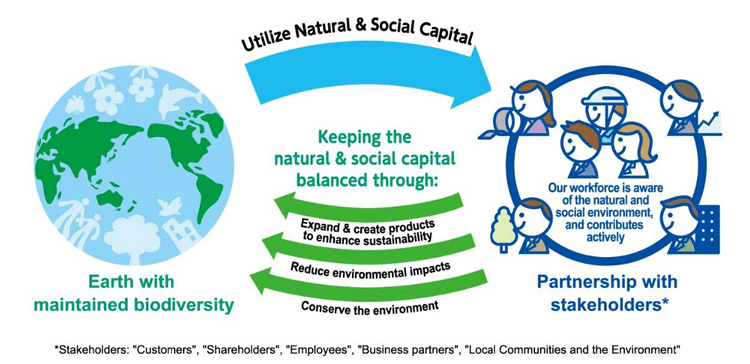
Figure. The SEKISUI Environment Sustainable Vision 2050
SEKISUI CHEMICAL Group is working to solve various issues regarding the natural and social environments through its corporate activities including products and business with the aim of creating an “Earth with Maintained Biodiversity” in 2050. By taking action with awareness that we are using the earth’s natural capital and social capital in our business activities and working to solve global issues, we will contribute to keeping natural and social capital balanced. As activities for achieving this, we will prioritize the following: (1) creation and expansion of markets for products that contribute to sustainability, (2) reduction of environmental impact, and (3) conservation of natural environment.
We will accelerate these activities by establishing in each employee an awareness of environmental issues and form groups of human resources with strong problem-solving capabilities, and collaborating with all stakeholders.
2. Review of the “SEKISUI Environment Sustainability Plan: Accelerate” (FY2017 – FY2019)
Under the previous medium-term environmental plan, we undertook measures to address the following three points: (1) monitor progress using the “SEKISUI Environmental Sustainability Index”, an integrated index; (2) increase sales of Environment-Contributing Products; and (3) reduce greenhouse gas emissions.
Table. Targets and Results Under the Previous Medium-term Environmental Plan
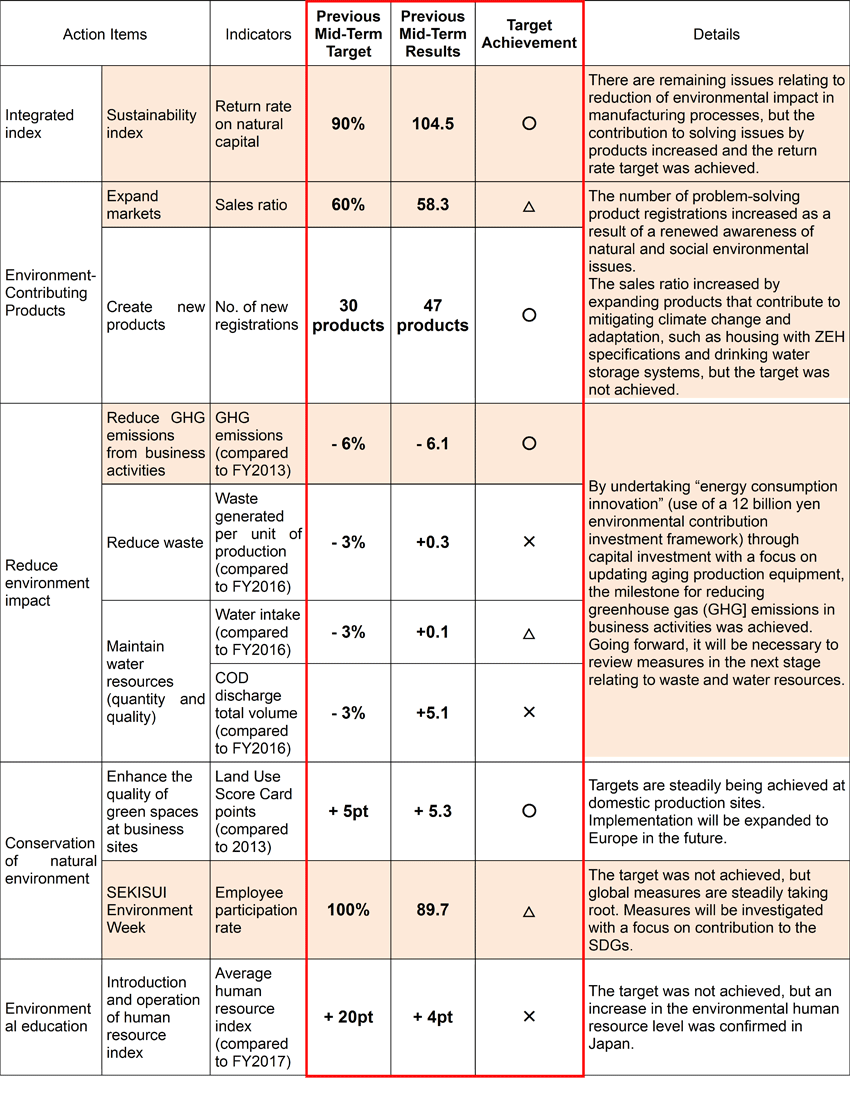
Notes
1. To calculate return rates, the “MiLCA” LCA calculation system based on the LIME2 concept developed by Professor Norihiro Itsubo of Tokyo City University and others is used.
2. Chemical Oxygen Demand: The amount of oxygen required to oxidize substances in water (oxygen consumption); an indicator of water quality. If COD is high, the amount of organic and non-organic substances in the water is high, and it can be determined that water quality is low.
As a result of these measures, we increased the contributions by products to solving environment problems and achieved a return rate on natural capital under the integrated index of 104.5%, which exceed the target. The target for Environment-Contributing Products as a proportion of sales was not achieved, but products that solve environmental problems were steadily developed and markets were expanded. With regard to reducing greenhouse gas emissions, an environmental contribution investment framework was used to actively update aging machines and introduce energy-saving equipment, and as a result, greenhouse gas emissions were reduced in line with the target (see figure below). There are still outstanding issues relating to reduction of environmental impact including reducing waste and maintaining water resources, and we will review measures.
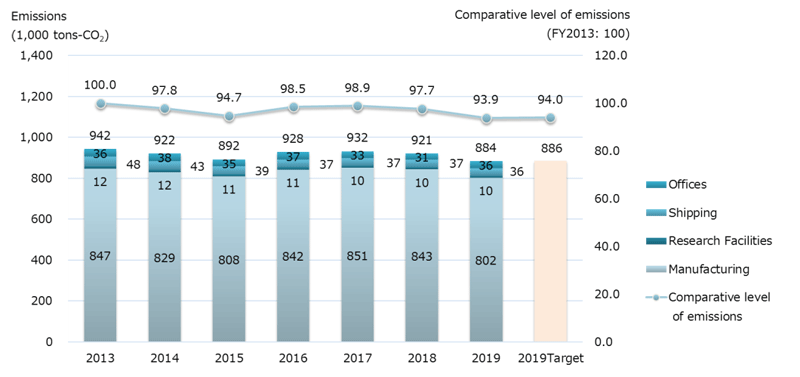
Figure. Changes in Greenhouse Gas Emissions in Business Activities
To conserve the natural environment, we took measures to enhance the quality of green spaces at domestic production sites by protecting rare species and developing environments for raising diverse wildlife. As a result, our score on the Land Use Score Card, an assessment tool, improved. We will expand these measures to Europe in the future.
In addition, through “SEKISUI Environment Week”, we believe that we have established the foundations of driving force for activities to undertake in order to identify and solve problems by globally undertaking practical measures to solve issues of the natural environment. Going forward, we will develop measures that contribute to solutions to issues of the natural and social environments into measures implemented with an awareness of contribution to the SDGs with the objective of developing human resources and a culture capable of considering solutions to problems and carrying them out.
3. “SEKISUI Environment Sustainability Plan: Accelerate II New Medium-Term Environmental Plan” (FY2020 – FY2022)
In the long-term environmental vision, we positioned climate change, depletion of natural resources, and water risks as priority environment issues and set the direction and long-term targets for each. With respect to climate change, we will seek to create a decarbonized society and reduce greenhouse gas emissions to zero in 2050; to address resource depletion, we will promote resource recovery for the circulation of resources with the aim of creating a circular economy; and with regard to water risks, we will identify risks and work to mitigate them with the aim of minimization. Based on the status we seek to achieve in 2050, we set medium-term milestones through a process of back-casting and formulated new medium-term plan. In the new plan, we set the following priority action items and target values.
3-1 Integrated Index
Monitoring progress using the “SEKISUI Environment Sustainability Index”, an integrated index, is intended to provide returns that can reduce the impact on not only natural capital but also social capital and increase contributions. We are working to double the scope of business by 2030 while maintaining a return rate of at least 100%.
3-2 Products to enhance sustainability
The “Environment-Contributing Product” program, a product assessment program intended to enhance the degree of contribution to solutions to issues in the natural and social environments and promote their widespread adoption that has been implemented since FY2006, will be was transformed into “Products to Enhance Sustainability” program in FY2020 in order to build up sustainability of solutions.
We believe that promoting products that increase contributions to solutions to issues in the natural and social environments will lead to enhancement of global and social sustainability. In order to continuously produce such products and expand social contribution, sustainability of the company and products themselves are essential. Because of this, in addition to existing processes for setting products that are highly effective in contributing to solutions to problems in accordance with in-company criteria, we created new perspectives of assessment of corporate and product sustainability. Specifically, we asses and audit sustainability from the perspectives of profitability, governance, supply chains, and customer satisfaction, among others. Furthermore, we select products with high levels of corporate and product sustainability that make significant contributions to solving environment issues, designate them as “Premium Products to Enhance Sustainability” and are taking measures to strategically support growth of those products.
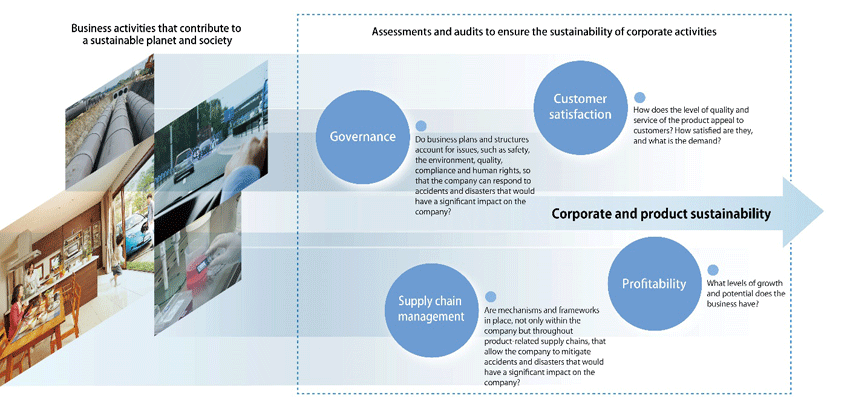
Figure. Products to enhance sustainability Program Concept
3-3 Measures to Address Climate Change
With the aim of establishing a decarbonized society, we set a long-term target of zero greenhouse gas emissions from business activities by 2050 and will seek to covert to 100% renewable energy for purchased electric power in 2030 based on back-casting.
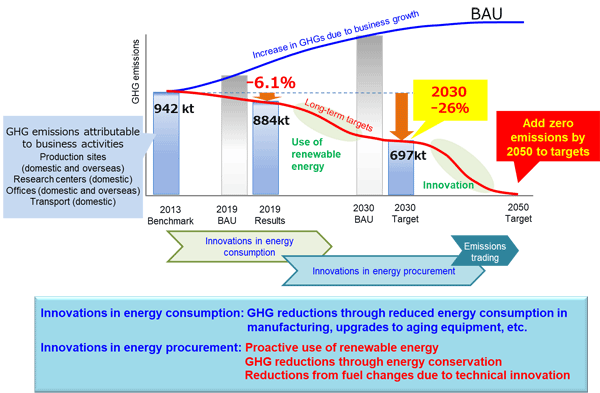
Figure. Roadmap for Reducing Greenhouse Gas Emissions
Note: BAU (Business as Usual): The increase in emissions in conjunction with normal economic activity
Under the roadmap for reducing greenhouse gas emissions (figure above), the previous medium-term environmental plan corresponded to the “energy consumption innovations” phase. We used a 12 billion yen environmental contribution investment framework to invest in energy-saving facilities with a focus on manufacturing and updating aging facilities, making substantial progress in curtailing greenhouse gas emissions. Under the new medium-term environmental plan, we will move to the “energy procurement innovation” phase. By using the Smart Heim Denki service, which was launched in April 2019, and a 40 billion yen ESG investment framework, we are actively moving towards procurement of renewable energy.
SEKISUI CHEMICAL became the world’s first company in the chemical sector to acquire SBT initiative certification1 in June 2018. We set greenhouse gas emissions reduction targets from a long-term perspective and have expressed our intention of working in collaboration with supply chains.
In August 2020, we joined RE100,2 a new initiative, with the aim of not just using renewable energy internally, but promoting its use throughout society.
1. Science Based Targets: With the adoption of the Paris Agreement, SBT initiative certification was proposed through joint initiatives including the United Nations Global Compact. With the SBT Initiative, company-set GHG reduction targets are certified as targets that are scientifically which contribute to long-term climate change measures.
2. Abbreviation for Renewable Energy 100%. RE100 is led by The Climate Group in partnership with CDP and operated as a part of the We Mean Business alliance. In Japan, the Japan Climate Leaders Partnership (JCLP) has supported participation and measures by Japanese companies as an official regional partners of RE100 since 2017.
Under our strategies regarding climate change issues, we are identifying the risks faced by the Company by climate change and formulating measures to mitigate those risks and transform them into opportunities. We disclose information on the background to those measures in accordance with the TCFD3 recommendations, and since expressing our commitment to the recommendations in January 2019, we have conducted periodic reviews and disclosed information starting since July 2019 (a review was conducted and information disclosed in August 2020).
For more information about the TCFD Report 2020, see the page below.
https://www.sekisuichemical.com/csr/assets/images/csr_tcfd_e2020.pdf
3. Task Force on Climate-related Financial Disclosures: A task force for climate change related financial disclosures established in 2015 by the Financial Stability Board (FSB), an international organization that seeks stability in financial systems.
3-4 Measures to Address Resource Depletion
To address resource depletion, in other words, resource circulation, we are promoting the circulation of resources as materials with the aim of creating a circular economy in 2050.
To date, we have taken zero-waste measures intended to completely eliminate landfill waste, primarily at production sites and have worked to reduce waste (= REDUCE). We have also focused on reusing housing units (= REUSE) and creating and expanding products made from recycled plastic material (= RECYCLE) and established bio-refinery (BR) technology, a type of chemical recycling technology for promoting resource circulation. BR technology uses microbial catalysts to product ethanol from waste.
Under the new medium-term environmental plan, we will promote resource circulation at production sites. We hope to verify the BR technology, promote practical implementation of chemical recycling technologies throughout society, and promote resource circulation. In addition to strengthening internal measures, we will also actively participate in various initiatives with industry organizations including CLOMA and JaIME, and collaboration with other companies to expand our contributions to solutions to social issues including the related problem of ocean plastic pollution.
3-5 Measures to Address Water Risks
We will use back-casting to set milestones and take action so that we can minimize water risks in 2050.
With respect to water risks, we have taken measures to reduce water intake and enhance waste water quality based on uniform standards at all production sites worldwide. We are aware, however, that water risk is a local issue and have adjusted the measures taken at each site. To maintain water resources, we set targets of cutting water intake at production sites with high water usage volumes by 10% (compared to FY2016) and cutting total COD of water released into rivers by 10% (compared to FY2016) at production sites with high COD release volumes. We will identify the risks unique to the watersheds where production sites are located, take measures that solve issues, and work to mitigate water risks.
Table. New Medium-Term Environmental Plan Targets
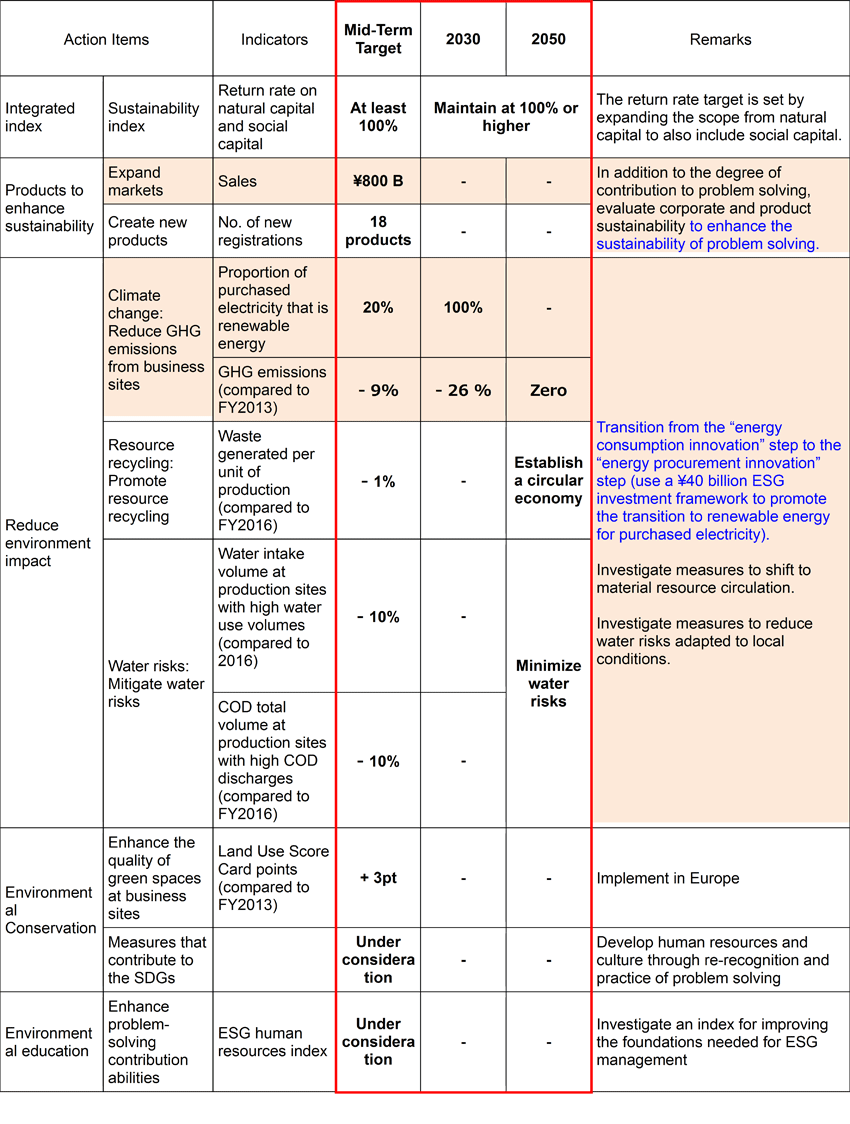
Reference: Positioning of the New Medium-Term Environmental Plan “SEKISUI Environment Sustainability Plan: Accelerate II”
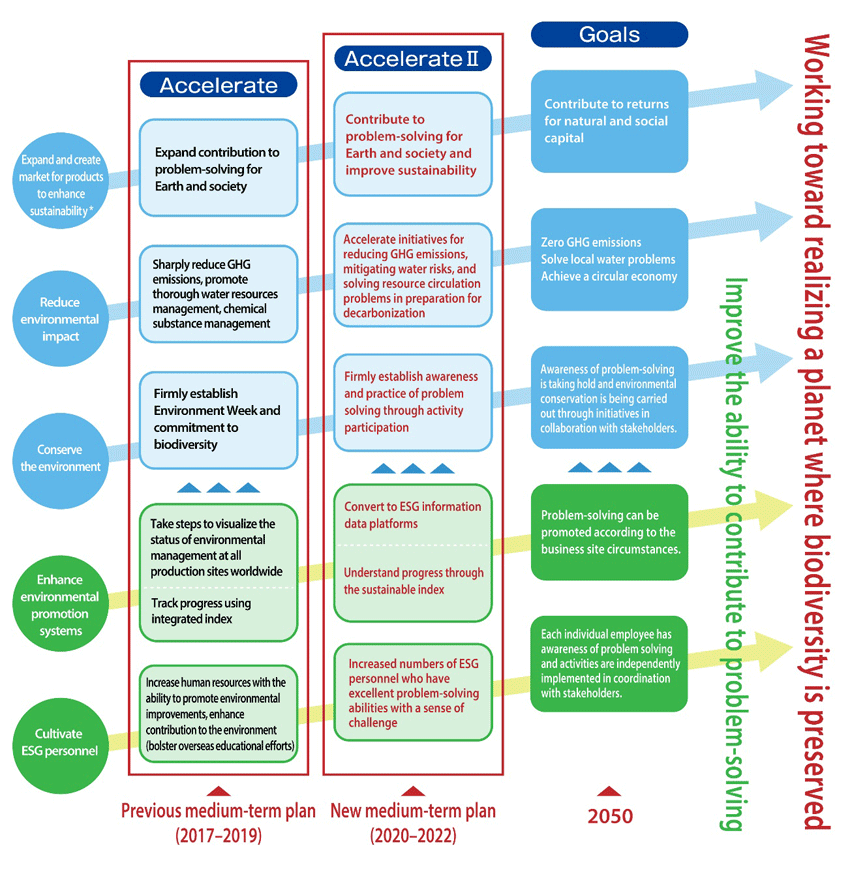
About SEKISUI CHEMICAL Group
Headquartered in Japan, SEKISUI CHEMICAL CO., LTD. (TSE: 4204) and its subsidiaries make up the SEKISUI CHEMICAL Group. 27,000 employees in over 200 companies throughout 21 countries and regions aim to contribute to improving the lives of the people of the world and the earth’s environment. Thanks to a history of innovation, dedication and a pioneering spirit, SEKISUI CHEMICAL now holds leading positions in its three diverse business divisions as well as top global market share in interlayer film, foam products, conductive particles and more.
Since its foundation in 1947, the SEKISUI CHEMICAL Group has dedicated itself to social and environmental contribution and is now an internationally recognized leader in sustainability and environmental initiatives, having recently been selected as one of the Global 100 most sustainable companies. SEKISUI CHEMICAL Group will continue to maintain a strong corporate presence for 100 years and beyond.
Press Contact
SEKISUI CHEMICAL CO., LTD.
Public Relations Department
Fax: +81-(0)3-6748-6547
Disclaimer
This press release may contain forward-looking statements. Such forward-looking statements are based on current expectations and beliefs and are subject to a number of factors and uncertainties that could cause actual results to differ materially from those expressed or implied by such statements due to changes in global economic, business, competitive market and regulatory factors.
